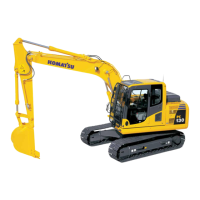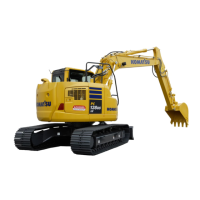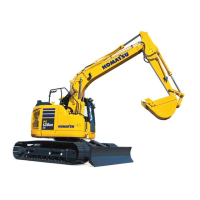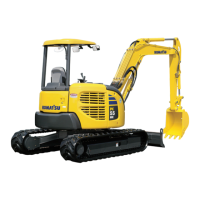SAFETY SAFETY INFORMATION
2-21
ENSURE GOOD VISIBILITY
This machine is equipped with mirrors to improve the visibility, but even with mirrors, there are places, which can-
not be seen from the operators seat, so always be careful when operating.
When operating or travelling in places with poor visibility, if it is impossible to confirm the condition of the job site or
obstacle is in the area around the machine, there is danger that the machine may suffer damage or the operator
may suffer serious personal injury. When operating or travelling in places with poor visibility, always observe the
following items strictly.
q If the visibility cannot be sufficiently assured, position a flagman if necessary. The operator should pay careful
attention to the signs and follow the instructions of the flagman.
q The signals should be given only by one flagman.
q When working in dark places, turn on the working lamps and front lamps of the machine, if necessary, setup
additional lighting in the area.
q Stop operations if there is poor visibility, such as in fog, snow, rain or sand storms.
q Check the mirrors on the machine before starting operations everyday. Clean off any dirt and adjust the view
to ensure good visibility.
VENTILATION FOR ENCLOSED AREA
Exhaust fumes from the engine can kill.
q If it is necessary to start the engine within an enclosed
area, or when handling fuel, flushing oil, or paint, open the
doors and windows to ensure that adequate ventilation is
provided to prevent gas poisoning.
SIGNALMAN'S SIGNAL AND SIGNS
q Set up signs to inform of road shoulders and soft ground. If the visibility is not good, position a signalman if
necessary. Operators should pay careful attention to the signs and follow the instructions from the signalman.
q Only one signalman should give signals.
q Make sure that all workers understand the meaning of all signals and signs before starting work.
EMERGENCY EXIT FROM OPERATOR'S CAB
If for some reason, the cab door does not open, use the rear window as an emergency escape. For details, see
Section “EMERGENCY EXIT FROM OPERATOR'S CAB (3-31)“ in this manual.
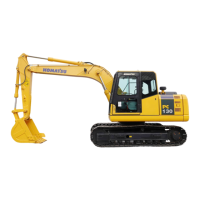
